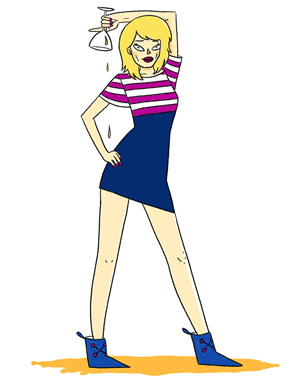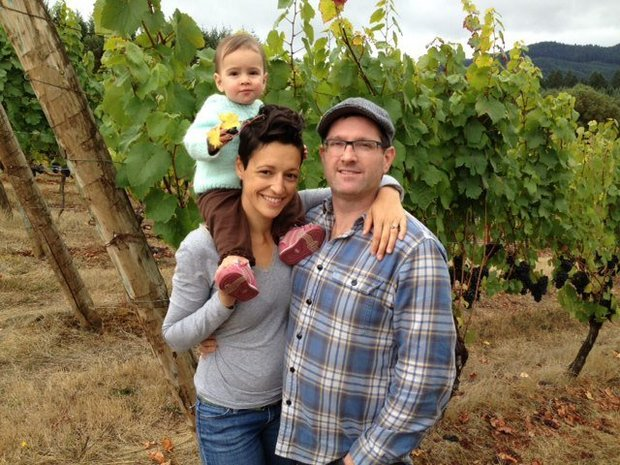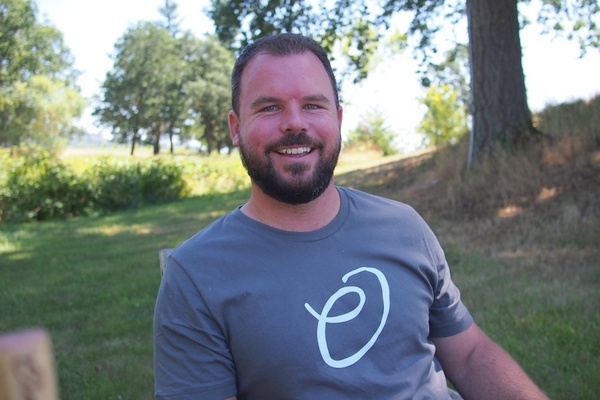
Chad Stock a man who likes to push the boundaries
So what’s afoot in Oregon? Clearly The Oregon Wine Board considers there is something new to taste and talk about – a story to tell of evolution, even of revolution, of a young wine producing region which is in the process of exploring a complex terroir, experimenting with new techniques, planting new grape varieties – of people keen to exploit the opportunities where only a small fraction the land suited to vines is planted and the restrictions are few. It’s attracting people who want to make their mark by ‘doing it different.’
In short the pitch was to publicise the ongoing pioneering spirit of Oregon. This was going to be illustrated by a flight of 11 wines.
In a blog last year I covered the three different soils types, Sedimentary, loess and volcanic… scroll down the blogs to check this out.
Life beyond Pinot
67% of Oregon is planted with Pinot Noir, more in the Williamette Valley where it has found its natural home and accounts for 74% of vineyards, but there is growing interest in other varieties. Of course there is Pinot’s natural partner – Chardonnay. In the 1960s – post prohibition – the pioneers at the time planted pretty much equal quantities of Pinot Noir, Chardonnay and Riesling.
Riesling bellyflopped – it was just not taken seriously having too much residual sugar and Chardonnay faltered, but has found its feet. A while back I wrote about the new ‘identity’ Chardonnay is forging in Oregon, so I was more interested in the spicy trio on show – Grüner Veltliner, Pinot Gris and Gerwürztramminer.
Evolutionary varieties
Minimus, Johan Vineyard, Grüner Veltliner 2015
This wine, made from Chad Stock (above), has an alluring aroma of honey-suckle and a hint of honey and wild flowers. There is richness to the texture and some weight, but also good acidity. It has structure and density. There is savoury spice and bite on the palate. I like this Grüner. It has plenty of personality.
It’s made with skin contact – two days maceration of the whole bunches in tank and after fermentation it goes through a full malolactic. That skin contract gives it good structure and the malo extra textural richness.
The grapes come from Applegate Valley. This emerging AVA is in the warmer more southerly part of the Williamette Valley, where higher sites are now being planted with cooler exposures. The Johan Vineyard lies on a north east facing slope and is kept cool by the sea air through the coastal mountain range.
It neatly illustrates evolution in terms of variety, technique and site all in one go – tick, tick, tick… not bad. Also in this more southerly part of Williamette, from the Illinois Valley on alluvial clay, we tasted this spicy wine.
Ovum Gerber Vineyard, Gerwuztraminer 2016
This was harvested late and it’s on a heavy clay and so frankly I was expecting it to be a bit flabby, but actually its had sufficient tension to create a good balance. The aromatics were undoubtedly florid and it’s a very exotic wine. Depends if you are a Gerwüzt fan. Some love it. A little goes a long way for my taste.
It was aged in 500l barrels, rather than the barriques traditionally favoured in Oregon. This is touted as an evolution. I’m all for less new wood, so I’m happy to publicise any move to moderation and the use of older, larger barrels.
Riesling was trotted out next. I was hoping for something steely and crisp and dry.
ARA Brooks Riesling 2016
This came from a number of sources in the Williamette valley but specifically from marine sedimentary and volcanic soils. It had a touch of minerality – nice, but quite a bit of residual sugar. If the objective was to illustrate evolution – it didn’t.
Given the mild disappointment of the Riesling, let’s revert to Chardonnay
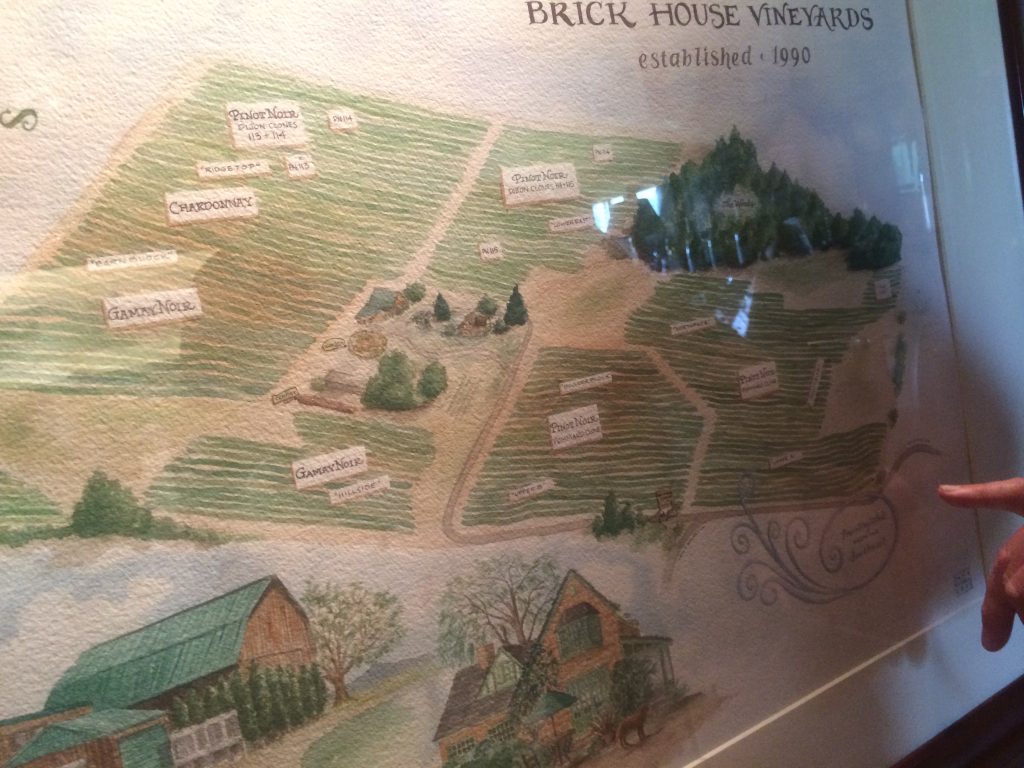
Brickhouse Cascadia Chardonnay 2014
2014 was a very warm vintage in Oregon so to find a Chardonnay with some tension is testament to a cooler vineyard site or perhaps to a more Chablis style of winemaking. Now this was from Ribbon Ridge AVA within Williamette, a ridge that rises from the Chehalem Valley floor which is not cooled by a breeze, so it’s a warmer part of cool… and this tension must be due to the winemaking or the sedimentary soil.
Rich and fruity. Quite an obvious wine, but I was impressed to find some backbone. This in part may be due to the sedimentary soil. In the Oregon last year we finished with a Chardonnay from the marine sedimentary soil which showed a lovely salty quality. It seems to make for more elegant, lighter-bodied, leaner wines with a savoury/dry minerality.
Moving to red…
Oregon was the first region to plant Gamay in the US and we were told ..“These pioneers continue to evolve the Gamay landscape through importation of new clonal material and blending with other varieties commonly found in the Williamette Valley.”
So here goes..and actually here goes really rather well. These are easy uncomplicated wines, but none the worse for that.
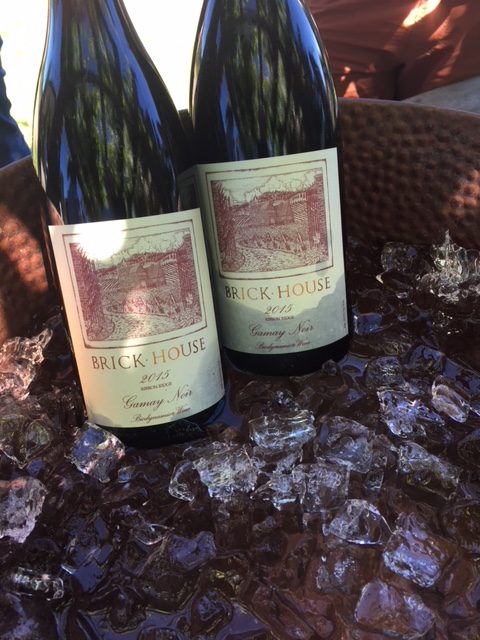
Brickhouse Gamay 2015
No carbonic fermentation here – this is made like a cru Beaujolais. It is spicy, smooth and quite deep. Gorgeous fruit. Soft and yet not flat. Yummy yummy fruit. This producer has just planted new clones – which I suppose qualifies them as innovative or at least progressive.
And so to some blends
Division Wine Co. Villages Breton
60% Cabernet Sauvignon, 30% Gamay and 10% Cot. This is a cross Oregon blend – presumably Gamay has been planted on pockets of granite, the soil type in Beaujolais.
Floral, high toned blue fruit aroma. Easy, fruity and accessible palate with soft tannins. A wine to glug and enjoy.
Bow and Arrow Rhinestones (60% Pinot Noir and 40% Gamay)
This is labelled Williamette, but it seems the Gamay grapes are from Johan, known for its granite and loam soils. This is apparently ground zero for the revolutionaries. It is made to respect the individual varieties so the Pinot Noir is destemmed, fermented separately and aged in older oak while the Gamay is treated to semi carbonic maceration and concrete. This is juicy and energetic wine. Fresh and sappy. I do like the fruity accessibility.
Scott Frank Bow and Arrow
Evolutionary Techniques
We were shown three wine made from Pinot Noir to illustrate evolution in winemaking approach. First up was Stoller Family Estate Pinot Noir 2015 to illustrate classic benchmark, by which a more Burgundian approach was meant. This came from the volcanic soils of the Dundee Hills and had been 100% de-stemmed, two days cold soak and mix of pigeage and remontage. It had good structure and depth. Firm tannins and good freshness.
Evolutionary?
It’s stretching a point for Kelley Fox, Mirabai 2015 to qualify as evolutionary simply because Kelly uses 100% whole bunch. But maybe this is evolutionary for Oregon.
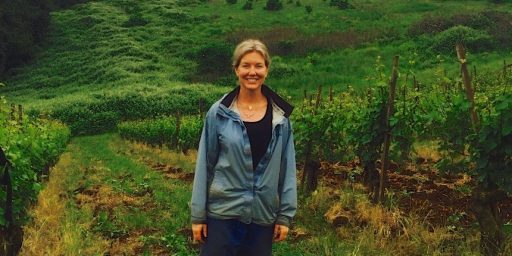
We were told that Kelley (above) is not interested in Pinot Noir, but in giving a voice to the terroir – um not sounding very evolutionary either! However the wine is very good – it’s ripe, but delicate. Very pure with silky tannins and a gentle fluidity to the palate with a slight herbal note – rather nice and maybe from the whole bunch.
Pushing the boundaries a bit further
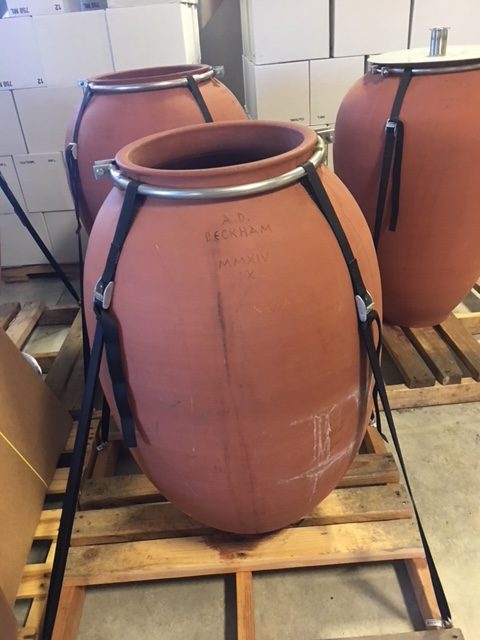
A.D Beckham Creta Pinot Noir 2015
Beckham is a potter. He taught pottery, made wine in the school holidays and wanted to bring the skills together so he began fermenting in his own amphora. He was influence by Elizabetta Foradori in Trentino. This has about 30% whole bunch and fermented naturally with no temperature control… so a cool ferment at 20-22 degrees. This amphora is not put into the ground as are some. The result is a pure fruit wine with a slightly iron note. Light tannins. It is both slightly dusty and very transparent on the palate. I like it.
Beckham might just revolutionise the market for amphora with his template design by which amphora may be produced in quantity. There is great demand for amphora for winemaking, but supply is limited and prices high given the hand making process. This template design would them more accessible. We may see more wines made in amphora in years to come, thanks to this potter from Oregon.
All good… I was buying into the the evolution theme until I inhaled the next wine – a bizarre Sav blanc.
Minimus SM1 Sauvignon Blanc
Another wine from Chad Stock (first photo). This is from the more southerly Applegate Valley It was cloudy, thick, sort of spicy and creamy. Consulting my notes, I did not like it. Now Chad is a producer clearly pushing boundaries. He used skin contact for 90 days in amphora and a full malolactic fermentation. His experiments are wide ranging for example he makes a brett wine and an oxidised wine. He plays with no less than 27 varieties. Interesting? Certainly. Nice? Well that’s questionable. That said his Grüner-Veltiner really hit the spot and I wold certainly like to try more of his wines.
I enjoyed this tasting. There is plenty afoot in Oregon. It’s clearly a dynamic place and the ‘evolution’ is exciting. However I am not sure I can say the same for the ‘revolution’. Wine making has a pretty long history and I wonder if there is anything truly both new and good that has not been done before. After all amphora fermentation is not truly revolutionary… just a blast from the past. It may seem revolutionary to experiment with an oxidised wine, but have we not age old examples of these already? Is this not full loop back to a ‘classic’ style. And take this last wine – various things have been trialled on Sauvignon Blanc and discarded with good reason. While evolution tends to be a positive thing, history tells us that revolution may not.

